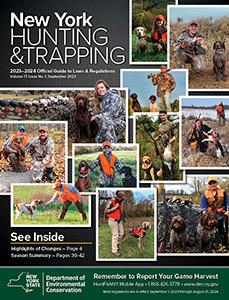Deer Recovery
By Bill Conners
Perched 15 feet off the ground, you saw that a buck you had been watching since late summer worked his way down a trail that brought him directly under your treestand. You did everything you could to maintain your composure, but in your excitement the perfect shot you took a few seconds later wasn’t so perfect after all. The deer bounded over the hill after your broadhead passed through the animal well behind the ribcage.
When you finally started tracking the deer, what started as a good blood trail, thinned to a drop here and there, before disappearing altogether. Eventually you concluded that your best hope of recovery was to call for help from Deer Search, Inc., a dedicated group of volunteers that help hunters locate what otherwise might have been a lost animal.
In 1986 the New York State Legislature authorized the Department of Environmental Conservation to license handlers to use leashed tracking dogs to assist hunters with the recovery of big game animals. Since then, Deer Search, Inc. volunteers and their dogs have helped recover thousands of harvested deer and bear across New York.
Jared Brueggeman, a member of Deer Search, Inc. from Delaware County, was exposed to the world of tracking dogs while helping his uncle track a deer when Jared was 17 or 18 years old. Watching the dog work and being a part of the recovery effort left him with a lasting impression that stayed with him through college. After graduating with a degree in wildlife science, his experience became the catalyst for his membership in the tracking organization.
Though Brueggeman’s interest had its roots in working with the dogs, he said, “I came to realize that each time a wounded or dead deer is recovered it fulfills our responsibility as conservationists and allows that animal to be used and enjoyed by the hunter and their family.”
Having volunteers ready to help with recovery does not absolve hunters of the need to carefully consider any shot they are about to take. Hunters must be proficient with the bow or gun they are about to use and must ask themselves if the animal is within range, is the field of view unobstructed, and just as important, is the deer or bear positioned correctly for a lethal shot through vital organs? You can’t let your excitement get in the way of good sense and ethical judgement.
Even if the deer does take off, a well-placed shot is going to make the dog’s job that much easier. “Sometimes we’re just the waterboy. The dog controls the track. The hunter will tell you the deer went out 50 yards, made a hard left and I lost it in thick cover. You put the dog on the track, and it takes you in an entirely different direction” said Marc Niad, another Deer Search member from Westchester County.



